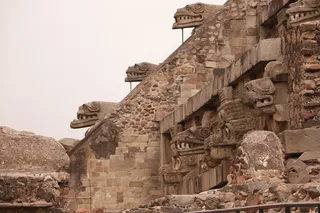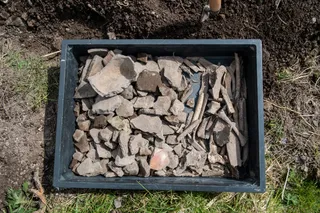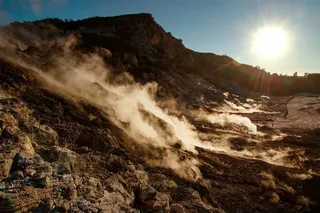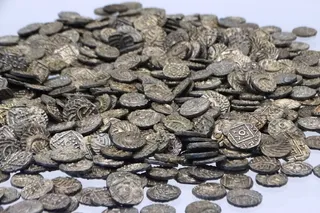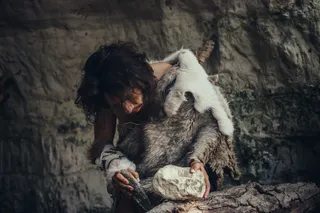To the Stone Age agriculturalists on Bornholm, a Danish island off the coast of Sweden, the best way to deal with bad weather was to sacrifice stones. That’s according to recent research in Antiquity, which reimagines the island’s sun stone artifacts as summons for the sun.
The stones appeared at the Neolithic, or New Stone Age, site of Vasagård approximately 4,900 years ago, at around the same time as a devastating volcanic winter in Northern Europe. The objects may have been sacrificial donations or offerings, deposited in ditches in an attempt to bring back warm weather and sunshine.
“One type of find that is completely unique to Bornholm is the so-called sun stones, which are flat shale pieces with engraved patterns and sun motifs,” said Rune Iversen, one of the authors of the recent research and an archaeologist at the University of Copenhagen, in a press release. “They symbolized fertility and were probably sacrificed to ensure sun and growth.”
Read More: What Was the Neolithic Revolution, and How Did It Change Human Societies?
Securing Sun in the New Stone Age
Researchers recently sampled and analyzed ice cores from Greenland and Antarctica, and found that the world was dragged into a dark volcanic winter sometime around 2,900 B.C.E. This was after a destructive volcanic eruption spewed volcanic ash and gas into the atmosphere.
Trapped in the air, this ash and gas dimmed the sun and dropped the temperatures across Northern Europe, likely devastating the crops and the communities that cultivated them.
“We have known for a long time that the sun was the focal point for the early agricultural cultures we know of in Northern Europe. They farmed the land and depended on the sun to bring home the harvest,” said Iversen, according to the release. “If the sun almost disappeared due to mist in the stratosphere for longer periods of time, it would have been extremely frightening for them.”
The team then started to rethink the artifacts on Bornholm. The discovery of the volcanic eruption and resulting volcanic winter may suggest that the sun stones at Vasagård were a response to climate crisis, meant to drive away the darkness of the sun.
Buried deliberately in an enclosure of banks and ditches called a “causewayed enclosure,” the sun stones were deposited with animal remains and pottery remnants.
“It is reasonable to believe that the Neolithic people on Bornholm wanted to protect themselves from further deterioration of the climate by sacrificing sun stones,” said Iversen, in the release. “Or perhaps they wanted to show their gratitude that the sun had returned again.”
Read More: Five Megastructures From The European Stone Age Still Around Today
An Ancient Climate Crisis
Whether these sun stones were deposited during the crisis or after, studies suggest that the crisis itself was severe. Lake varves — the annual layers of sediments that sit at the bottom of some lakes — reveal reduced solar radiation around 2900 B.C.E., indicating a decrease in sunshine and warmth. And tree ring analyses suggest that the spring and summer months around that time were tormented with frost.
According to the team, Bornholm changed in the aftermath of the volcanic eruption and winter. Though the Funnel Beaker culture, thus dubbed for its distinctive funnel- and beaker-shaped pottery, had defined the island previously, the culture began to fade away around 2900 B.C.E. Afterwards, it disappeared along with its characteristic ceramics and burial enclosures.
“At the causewayed enclosure we have excavated on Bornholm, we can also see that, after the sacrifice of the sun stones, the residents changed the structure of the site,” said Iversen in the release. “We do not know why, but it is reasonable to believe that the dramatic climatic changes they had been exposed to would have played a role in some way.”
While many mysteries remain about the agricultural communities on Bornholm, the team’s reinterpretation sheds light on their most mystifying artifacts, made in what may have been the communities’ darkest times.
“With the sun stones, there is in my mind no doubt,” said Lasse Vilien Sørensen, another author and an archaeologist at the National Museum of Denmark, in the release. “It is quite simply an incredible discovery, which demonstrates that depositions honoring the sun [are] an ancient phenomenon.”
Read More: How Hunter-Gatherers Used The Land Around Stonehenge
Article Sources:
Our writers at Discovermagazine.com use peer-reviewed studies and high-quality sources for our articles, and our editors review for scientific accuracy and editorial standards. Review the sources used below for this article:





